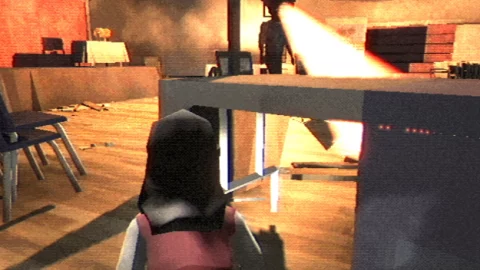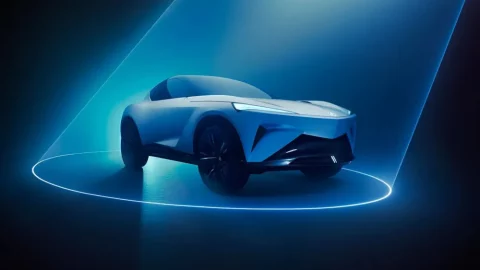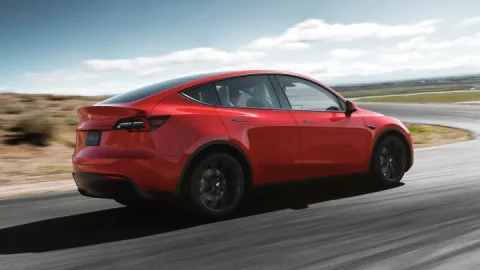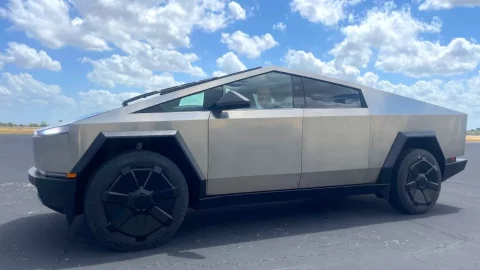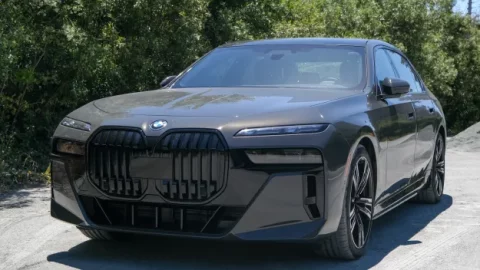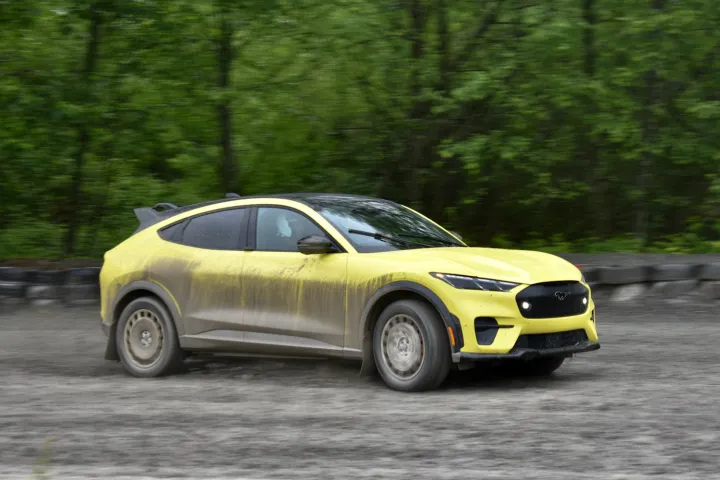
Stephen Edelstein/Digital Trends
Ford promised an electric SUV infused with the spirit of the legendary Mustang performance car with the Mustang Mach-E. Well into its production run, the Mach-E is living up to the Mustang name in that Ford intends to expand the number of Mach-E variations, just like it does with the standard internal-combustion Mustang coupe and convertible.
After its introduction for the 2021 model year, the Mach-E is getting close to the point where most cars would receive a redesign, or at least a significant update. This seems especially important considering the emergence of newer competitors such as the Hyundai Ioniq 5, Kia EV6, and Chevrolet Blazer EV. However, the big news for the 2024 Mustang Mach-E is not a redesign, but rather the addition of a new Rally model intended for off-road use.
The Mach-E Rally is inspired by Ford’s history of rallying as well as the contemporary movement of converting suburban SUVs into light off-road vehicles that are more adept at navigating dirt roads but fall short of truly capable rock crawlers. In order to achieve this, the Mach-E Rally is equipped with a powerful dual-motor drivetrain, a raised suspension, and dirt-ready tires. The Rally is one of the most expensive Mach-E models, though, with a starting price of slightly over $60,000.
Design
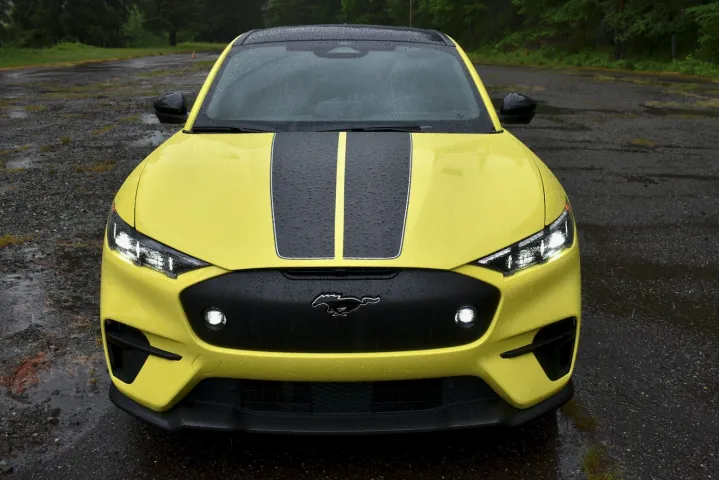
Ford is somewhat muddying its lore with the Rally, but the Mach-E controversially injects an electric crossover SUV with Mustang-like styling elements. Ford has a great deal of legitimate rallying experience thanks to models like the Focus, RS200, and Escort, but the Mustang has focused primarily on speed on asphalt rather than dirt.
Nonetheless, the Mach-E Rally appears prepared for a swift sprint through the woodland. This is not your typical Mach-E, as evidenced by the racing stripes, rear spoiler, and prominent front splitter. The fog lights integrated into the grille and white 19-inch wheels scream “rally car.” From a functional standpoint, Ford modified the Mach-E Rally by adding underbody shielding to safeguard the motors, raising the ride height by one inch, and equipping the vehicle with Michelin CrossClimate2 tires, which offer enhanced traction on uneven terrain.
The Mach-E Rally looks ready for a fast run through the forest.
Regarding styling, the Mach-E itself continues to lean toward the low-profile side of the electric SUV spectrum, more in line with the Kia EV6 and different from the almost completely unstyled Tesla Model Y, the more conventional-looking Chevrolet Blazer EV, and the retro Hyundai Ioniq 5. Both rows’ headroom and legroom are comparable to those of these competitors, and the Ford’s 4.7 cubic foot trunk is marginally roomier than a Model Y’s.
The minimalist aesthetic that appears to be popular with EVs at the moment is followed in interior design. There is not much else in the cabin to draw attention to, so the large infotainment touchscreen and digital instrument cluster stand out. The interior does not feel flimsy or cheap, though; the material quality seemed reasonable given the price range.
Tech
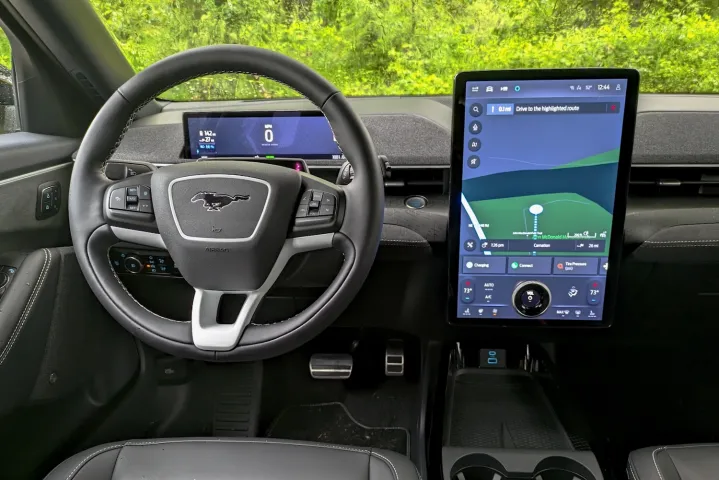
The infotainment system on the Mustang Mach-E for 2024 is Ford’s Sync 4A, not the new Ford Digital Experience system that will soon be available on some of the automaker’s other models. Additionally standard are a 10.2-inch digital instrument cluster, a 15.5-inch portrait-oriented touchscreen, wireless Apple CarPlay, and Android Auto.
The touchscreen, which protrudes from the dashboard like a flatscreen TV mounted on the wall, is functional but not subtle. With the help of over-the-air (OTA) updates, Ford has been able to accomplish most tasks with the least amount of menu surfing since the Mach-E’s release. Additional updates have concentrated on enhancing Bluetooth connectivity and expanding the capabilities of the larger analog knob that is integrated into the screen (it can now control audio volume, seat heaters, and temperature). Still, the on-screen climate controls can be a bit tricky to work.
The touchscreen isn’t subtle, but it is functional.
The Rally has the same standard driver-assistance features as other Mach-E models, including adaptive cruise control, automatic emergency braking, blind spot monitoring, rear cross traffic alert, lane keep assist, and forward collision warning. Ford’s hands-free highway driving system, BlueCruise, is also available; however, long-term use requires a subscription. Following a 90-day free trial, customers can choose to buy a three-year subscription. Ford ships vehicles equipped with BlueCruise hardware, but software is required for the system to function.
The Mach-E gets an updated BlueCruise 1.3 version for 2024. Compared to BlueCruise 1.2, which introduced automated lane changes, this update is not as significant. According to Ford, BlueCruise 1.3 does not add new features; rather, it focuses on improving the system’s behavior to extend the amount of time that can be driven hands-free. Software calibrations have been made to enhance performance in narrow lanes and on tight turns. After testing the update on a Mustang Mach-E Premium, we discovered that although it remained in hands-free mode almost all the time, it also had a tendency to veer to the right of lanes that were momentarily narrowed for construction. As a result, we were brought a little closer to other cars than we would have liked.
Driving experience
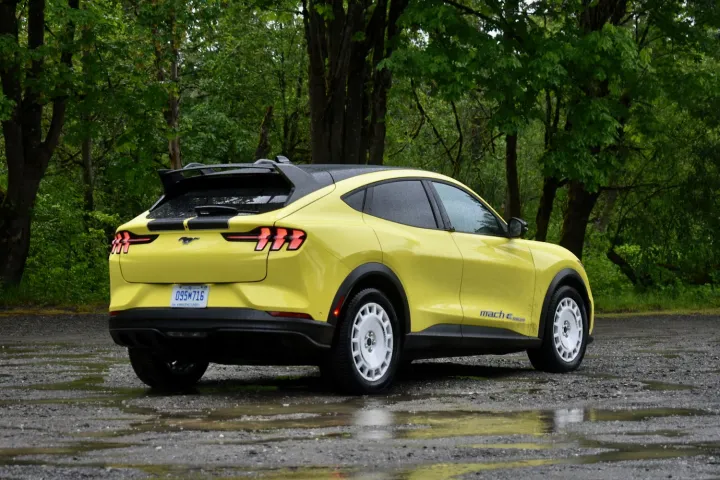
The Rally’s dual-motor all-wheel drive powertrain is the most powerful Mach-E available right out of the factory because it is tuned the same as the Mach-E GT with the optional Performance Upgrade. According to Ford, the Rally’s output of 480 horsepower and 700 pound-feet of torque will enable it to accelerate from zero to sixty miles per hour in 3.4 seconds. That’s 0.1 second slower than the Mach-E GT, but the same as a Tesla Model Y Performance.
With so many point-and-shoot electric vehicles on the market right now, the Mach-E Rally is unique.
The Mach-E Rally is truly exceptional, though, because it has a Rally Sport drive mode that maximizes acceleration and power on terrain that would send a regular Mustang racing back to the stables. This mode relaxes the electronic safety net to allow the car to go sideways in corners, which is part of the fun of driving on low-traction surfaces like dirt and mud. Additionally, it is tuned for sportier damping and more linear accelerator response, allowing you to steer the car through corners with the right pedal.
With so many point-and-shoot electric vehicles on the market right now, the Mach-E Rally is unique. This Ford will demonstrate to you that traveling sideways can be just as enjoyable as traveling swiftly in a straight line if you find a peaceful section of dirt road or a large parking lot. This is made simple by the software mapping for the Rally Sport mode and the electric powertrain, which maintain a constant response from the car to accelerator and pedal inputs. As of right now, a much more expensive Rivian is the closest thing to this kind of hooligan behavior in an EV.
Though not every driver will have access to a dirt playground big enough to see a Mustang Mach-E Rally show off its skills, this was a smart choice when it came to building an electric vehicle. Similar to other Mach-E models, driving the Rally is an enjoyable experience. It may even be the best daily driver in the lineup thanks to the GT model’s 480 horsepower and softer suspension. However, despite its long wheelbase and relatively heavy design, this car is not very agile on pavement. Those things do not seem to matter as much on dirt, though, when you just power the car through a corner by rotating the rear end.
Range and charging
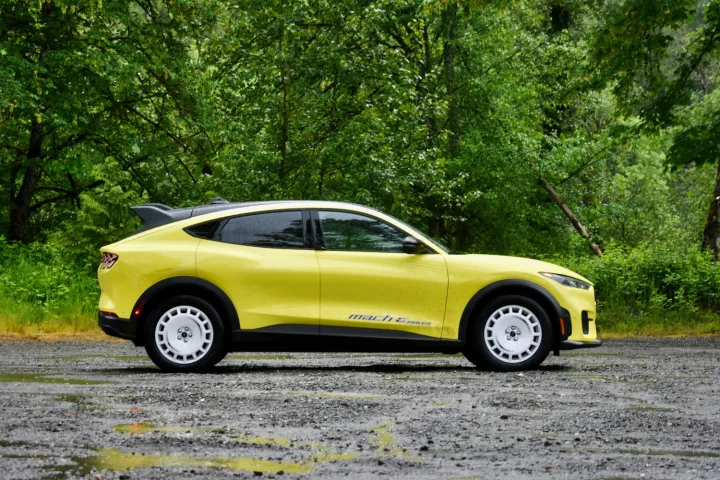
A 91 kilowatt-hour battery pack, which is standard on all models except the base Mach-E Select grade (that model has an optional extra), powers the Mach-E Rally. However, the Mach-E GT’s 280 miles and the Select and Premium models’ 300 miles of all-wheel drive are greater than the estimated 265 miles of the Rally (Ford also offers this pack in rear-wheel drive Premium models, stretching range to 320 miles).
The Mach-E Rally can charge from 10% to 80% in a respectable 32 minutes, according to Ford, with a maximum DC fast charging power rate of 150 kilowatts. A full Level 2 AC charge takes approximately 10 hours.
Ford is also working on ways to make charging a Mach-E easier. Mach-E drivers can connect to Tesla Supercharger stations using shipping adapters, and the cars are equipped with the required software to communicate with these stations. Additionally, the automaker included Intelligent Range, a built-in route-planning feature that includes charging stops when utilizing the integrated navigation system. Additionally supported is Apple Maps EV routing. According to Ford, a future OTA update for Google Maps will include a feature similar to this one.
The battery warranty, which is eight years or 100,000 miles (whichever comes first), is similar to that of other EVs. This is on top of the car’s three-year, 36,000-mile bumper-to-bumper warranty.
How DT would configure this car
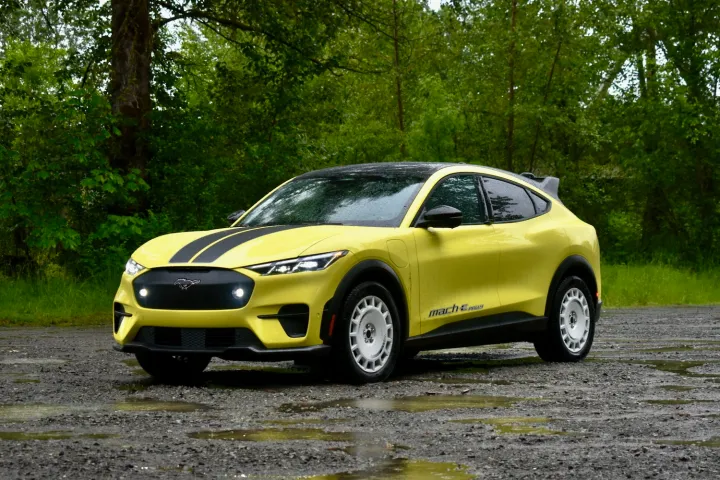
Even though the Mach-E Rally is a fascinating new model, it is not the best option. The same range of technological features are included in the base Select and one tier higher Premium models, which are also reasonably pleasant to drive even though they are not as fast. Furthermore, a Mach-E GT with the Performance Upgrade costs approximately $5,000 less than the base price of the Rally, which is $61,890. It will also be almost the same experience unless you drive on dirt a lot.
Additionally, buyers can obtain a Tesla Model Y Performance with a 279-mile range for roughly $10,000 less. In comparison to the Kia EV6 GT, which costs roughly the same and has more power but only 218 miles of range (though with more potent DC fast charging), the Mach-E Rally does, at least, appear to be a good value. The Ford also makes more sense as a daily driver than the Hyundai Ioniq 5 N, which costs $67,475 and needs a racetrack to justify its existence.
Right now, the market does not really need a niche performance model because there are not many affordable EVs available. However, the Mach-E Rally is a skillfully designed product that builds on the strengths of the original Mach-E while diverging from rivals in terms of performance and design. Furthermore, it is not just unique for the sake of uniqueness. We need more EVs, but the Mach-E Rally also shows that we need more rally courses.
